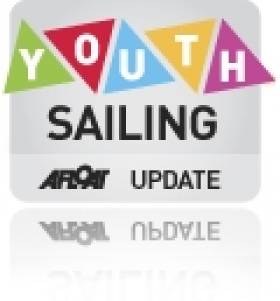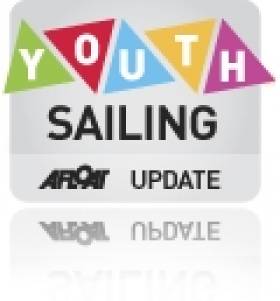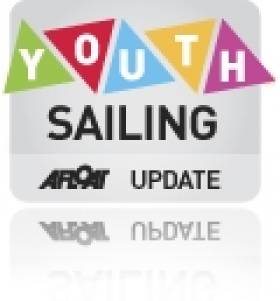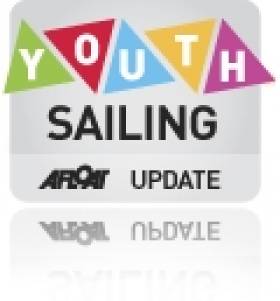Displaying items by tag: youth sailing
#UCD – University College Dublin (UCD) sailing team won the five race Student Yachting Nationals title in Howth at the weekend to qualify for the Student Yachting World Cup (SYWoC) in France and represent Ireland in La Rochelle later this year.
It's more top marks for the Dublin college whose watersports clubs have already taken wins in the 2014 Sailing intervarsities in Wexford, the inaugural Kitesurfing Championships and rowing's Gannon Cup on the river Liffey.
The team was made up of previous SYWoC sailors Philip and Simon Doran (Afloat Sailor of the Month for March), Ben Fusco and Sophie Murphy, with Will Byrne on bow.
The team are returning to La Rochelle in October to try win back the trophy first won by them in 2012.
Youth Sailors Brave Chilly Waters at Dun Laoghaire for Sailing School Fun
#inss – There were plenty of thrills and spills in Dun Laoghaire harbour last weekend when local youths took to the chilly February waters as part of the Irish National Sailing School's year round sailing syllabus.
The Irish National Sailing School Junior Club is a way for young sailors to keep sailing during the school terms. Sailors have a choice of sailing either from 10am to 1pm or from 2pm-5pm on Saturdays.
While they primarily sail in dinghies, on the particular cold days children take out fleet of keelboats (1720s and Squibs) allowing them to keep sailing and stay warm in the colder conditions. Sailing on the bigger keelboats also broadens the children's skills and allows them to venture further afield.
Children from as young as 7 are out sailing in the club every Saturday combining the fun and skills of sailing while making new friends and socialising says centre principal Kenneth Rumball. 'There are always plenty of spaces available with new sailors welcome to sign up at any stage', he adds.
The Summer term is running on the following Saturdays February 1, 8, 15, 22 March 1, 8, 15, 22, 29 April 5, 26 May 3, 10. During the 13 weeks children build on their sailing skill and progress through their logbooks to ensure they are learning all the time and gaining extra valuable skills along the way.
For full dates, time and prices see the Junior Club Sailing website
Irish Youth Teams Eighth & Ninth at Student Yachting World Cup
#sywoc – Irish sailing teams lie eighth and ninth after the fourth day of racing at the Student Yachting World Cup in France. The Swiss team had an outstanding performance to be in second place but it is still the French hosts from Kedge BS that keep the lead in Ponic.
The 14 schools raced J/80s in four windward-leeward races. UCD are eighth and an Irish Universities team is ninth. Results here
Ireland Lying Fourth at Student Yachting World Cup, France Leads
#sywoc – Ireland lies fourth at the The Student Yachting World Cup in France. Yesterday, the French team dominated the races but got an OCS penalty in one windward leeward race. The final ranking of the first day was: The USA first (16 points), then France (2nd, 18 points) followed by Scotland (3rd, 20 points). The others' ranking was Ireland (4th), Switzerland ( 5th), Australia ( 6th), England (7th), Belgium (8th), Defender (9th), Norway (10th), X-HEC (11th), Japan (12th),Germany (13th), China (14th).
As the weather condition was not as good as yesterday, the first windward leeward race was the occasion to show how strong the crews were. Switzerland first dominated the race but had trouble in the third round, they finished fifth. The leader of yesterday, France proved the former victories were not a blow dealt by fate. They eventually won this race. Belgium and Australia were side by side but the latter had been faster to set the spinnaker in the last round and finished second.
Today has been a thrilling day of races. Weather conditions were tough and the teams came back to the harbour exhausted. France proved they will be strong competitors and got the top position on the podium. (from Michalis Pateniotis, www.icarussailingmedia.com).
Dun Laoghaire Versus Howth for Student Yachting Worlds
#sywc – Keeping the top student sailing teams together is a challenging task, as the usual three to four year period at university means that personnel turnover is inevitably rapid writes WM Nixon. Then too, it has to be remembered that students are at university in the hope of getting a degree, so at times the demands of preparing for exams have to take precedence over sport.
This situation has resulted in the Irish campaigns in the week-long Student Yachting Worlds – which begin this weekend at Pornic in Brittany – becoming something of a local derby between Dun Laoghaire and Howth.
Defending champions UCD – who had a runaway win in the series in France last year – did so under the umbrella of the Royal St George YC in Dun Laoghaire, which put so much in the way of boat availability, facilities and coaching towards helping the UCD team beforehand that their success contributed to Royal St George becoming the Mitsubishi Motors "Club of the Year".
With their win, it meant that UCD have a place as of right in this year's Worlds. There has been a change of format for the event, which will now be sailed in J/80s, resulting in a more compact crew which in UCD's case will be drawn from all over Ireland, but currently focus on Dun Laoghaire in their sailing. The team is Philip Doran (Courtown), Ben Fusco (Kinsale), Bella Morehead (Cork), Sophie Murphy (Strangford Lough), and Conor Murphy (Howth), while UCDSC Commodore Vinnie Varley (Malahide) is travelling as reserve.
UCD already having a place, the other Irish universities were then entitled to compete for the position of national representatives. This series was sailed on Saturdays in April at Howth in J/80s , and University of Limerick skippered by Rob O'Leary were winners. But by August, it was becoming clear that any hopes of a UL team getting itself together again and going to France were very slim, so the baton was passed to Dublin City University, who had been runners-up in the selections series, helmed by Ryan Scott of Howth.
But as with the other colleges, DCU's team were scattered far and wide by August, with many of them likely to stay so. However, consultation with the organizers revealed a fairly liberal set of rules regarding the selection of team personnel, and in the end Team Ireland DCU has been built entirely around the junior membership of Howth YC.
The core of the crew is still the winning DCU squad, but other colleges are involved. Ryan Scott (DCU) is helm, while mainsheet/tactician is Shane Giviney (DCU). Tactical input can also be expected from mid-boat crew Diana Kissane (TCD) and Sam O'Byrne (also TCD), while the bowman is Luke Malcolm (Dublin Institute of Technology).
This Howth College team (there actually was a third level College of Howth once upon a time, but that was back in the late Mediaeval era) have had only a few weeks to get organised on a training programme and seek some action. Yet they were on the upward graph in the recent British Match Racing Series in J/80s when the final day's racing had to be scrubbed, despite which they placed four overall.
The Student Yachting Worlds 2013 have attracted teams from fifteen counries, including Japan and China, with Dalhousie representing Canada while the Naval Academy in Annapolis sails for the US. The event gets under way from October 12th, and there's an inaugural Crew Dinner when each team is expected to provide a dish representative of their national cuisine, while racing is from October 14th to 19th.
Royal Cork Ace Seafra Guilfoyle Claims Junior All Ireland Sailing Title
#juniorallireland – Former Optimist star Seáfra Guilfolyle sailing with Richard McGinley from Royal Cork Yacht Club outwitted two Irish world sailing champions today to be crowned the 2013 Junior All Ireland Sailing Championship after a close nine race regatta at Schull Harbour in West Cork. Full results downloadable below as a jpeg file.
Going in to the medal race Guilfoyle was tied on points at the top of the leader board with Finn Lynch, who only two weeks ago won the U21 Laser Radial World Championships. But a fourth for Seáfra in the medal race was enough to put him two points clear of Finn to claim the prestigious title.
The championship got under way at the Fastnet Marine OEC in Schull, Co. Cork yesterday (Saturday) where the initial five scheduled races were successfully sailed and concluded today with three further fleets races followed by a double points medal race for the top 10 boats. 23 of Ireland’s top young sailors take to the water in locally built TR3.6 dinghies.
Racing began this morning in light to moderate winds in Schull Harbour. Finn and his crew Florence Lyden had been the overnight leaders but dropped back to third after the first race while Darragh O’Sullivan, and his teammate Anna O’Regan took the lead with Seáfra and Richard McGinley in the silver medal position. Only three points separated the three sailors and with two more fleet races and a double points medal race yet to be sailed, every move and tactical decision would be critical.
Proving just how tight the competition was, it was Seáfra won took pole position with a bullet in Race 7 knocking Darragh back to third place while Finn moved up to take second overall. And the battle continued during Race 8 when a win for Finn meant both he and Seáfra were tied on 21 points with only the medal race left as the decider.
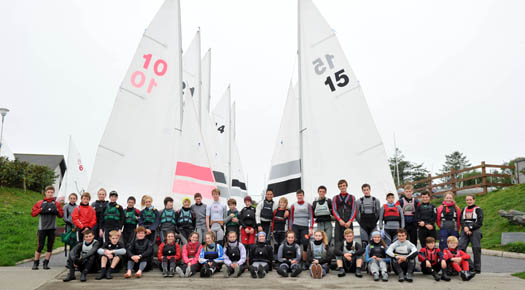
Competitors at the ISA All Ireland Junior Sailing Championships in Schull Photo: Michael Mac Sweeney/Provision
Both Seáfra and Finn got off to a tricky start in the medal race. They, along with Darragh, were towards the back putting them in the difficult position of having to climb up the fleet. But with a wealth of skills and international experience the talented sailors worked the conditions improving their positions. At the end, Seáfra couldn’t quite reach the top three but a fourth place finish was enough to beat Finn’s fifth giving him the Gold with a two point lead.
Commenting on his win Seáfra enthused “The medal race was really nerve-wracking especially having Finn so close to me the whole time but I’m really happy with how I sailed. I’m delighted with the outcome and I’m looking forward to getting to compete at the Senior All Irelands next month in Howth”.
Youth Sailors Durcan v Lynch Battle for Lead at All Ireland Juniors in Schull
#juniorallirelands – Optimist champion Johnny Durcan and Patrick Crosbie share the lead of the All Ireland Junior Sailing Championships with U21 Laser Radial World Champion Finn Lynch and crew Florence Lyden at today's halfway stage of the Schull regatta. Five races have been sailed with one discard so far. Full results downloadable below.
The championship got under way today at the Fastnet Marine OEC in Schull. The invitational regatta saw 23 of Ireland's top young sailors take to the water in TR3.6 dinghies for the initial five races. A further three more races may be sailed tomorrow (Sunday) followed by a double points medal race decider for the top 10 sailors.
A heavy mist hung over in Schull Harbour for the initial race obstructing viewing of the windward leeward course from the shore completely. At 11.30am the sailors crossed the start line for the first time in the light to moderate south westerly breeze. Taking the first bullet was Darragh O'Sullivan (Laser Radial) and his crew Anna O'Regan followed by Johnny Durcan (Optimist) and Patrick Crosbie with Seafra Guilfoyle (Laser Radial) and Richard McGinley in third.
Lynch had a seventh in the first race but he and Lyden quickly improved their form. In their subsequent races they had a 2, 2, 1 and a 10, which is discarded, to finish at the halfway as joint leaders along with Durcan and Crosbie.
Only one point behind the leaders in third place are Darragh O'Sullivan and his crew Anna O'Regan who had a 1, 8, 7, 3, 2 leaving them on a total of 13 points after the discard. In fourth and on 14 points is Seafra Guilfoyle.
Youth Sailing Stars Compete at Junior All Ireland Sailing Championships in Schull
#youthsailing – Two Irish youth sailing world champions are among a fleet of 23 junior sailing stars set for this weekend's Junior All Ireland sailing championships in Schull, West Cork.
This month's U21 Laser Radial World Champion Finn Lynch is a wild card entry into the competition and Northern Ireland Topper World Champion Liam Glynn is also invited.
The championships takes place in a fleet of locally built and raced TR3.6 dinghies at Schull Harbour. The invitation only championship includes representatives selected from nine different youth classes but disappointingly there is no junior participation from many of Ireland's senior sailing classes.
Last year Baltimore sailor Fionn Lyden won the championship with nine wins from nine races in the TR3.6 boat.
11 clubs from a network of over 100 are represented with the Royal Cork YC and National YCs sending five sailors apiece.
The full listing of invitees is as follows:
420 Harry Whittaker Royal Cork YC; Laser 4.7 Sarah Cooney National YC; Laser 4.7 Ciaran Finnegan Waterford Harbour SC; Laser 4.7 Cliodhna O'Regan Kinsale YC; Laser Radial Cian Byrne Royal Cork YC;
Laser Radial Ryan Ballyholme YC; Laser Radial Seafra Guilfoyle Royal Cork YC; Laser Radial Darragh O'Sullivan Kinsale YC; Laser Standard Cian Cahill Royal St George YC; Mirror Megan Boylan Skerries SC;
Mirror Tiarnan Dickson Lough Ree YC; Optimist Harry Durcan Royal Cork YC; Optimist Johnny Durcan Royal Cork YC; Optimist Megan Parker Skerries SC; Optimist Loghlen Rickard National YC;
RS Feva Jack Higgins Royal St George YC; Topaz Rob Wynne Dungarvan Harbour SC; Topper Liam Glynn Ballyholme YC; Topper Nicola Hemeryck National YC; Topper Daniel Raymond National YC; Topper Conor Sheriff Courtown SC; Sarah Eames Ballyholme YC and Finn Lynch National YC
Should Ireland Bid for ISAF Youth World Sailing Championships Again?
#youthsailing – The Government was thrilled with it, Dun Laoghaire was thrilled with it, ISAF itself was thrilled with it. The Four Star Pizza sponsored Youth World Sailing Championships in Dun Laoghaire in 2012 was widely acknowledged as one of the 'best ever' run. Now the right to stage the event in 2017 is up for grabs. Is there any reason it could not come back to Ireland, in line with the Irish Sports Council policy of promoting youth sailing?
Arising out of its staging the host Royal St. George Yacht Club won the Mitsubishi Club of the Year Award.
ISAF is inviting all Member National Authorities to bid for the 2017 ISAF Youth Sailing World Championship.
The ISAF Youth Sailing World Championship is ISAFs longest running event, having taken place every year since the first championships hosted by Sweden in 1971.
The event has been held in 26 countries over the past 43 years. The 43rd edition took place from 13-20 July in Limassol, Cyprus before the flag was passed over by Cypriot sailors to the Portuguese team, host team of the 2014 ISAF Youth Worlds that will take place in Tavira. Langkawi, Malaysia will host the 2015 ISAF Youth Worlds before it heads to Al Musannah Sports City, Oman in 2016.
In advance of the 2013 ISAF Annual Conference in Oman, ISAF is inviting bids to host the 2017 ISAF Youth Sailing World Championship.
A new addition to the Bid Manual for the 2017 ISAF Youth Worlds includes investing in the legacy of the Youth Worlds. On the importance of a long lasting legacy ISAF Youth Worlds Technical Delegate Antonio Gonzalez de la Madrid said, "It is vital that MNAs think about the lasting legacy hosting an event of the ISAF Youth Worlds stature can have on sailing within their nation."
MNAs interested in bidding should contact the ISAF Secretariat here to receive the bid manual. The deadline for bids is 15 October 2013. Bids will be reviewed by the Youth World Championship Sub-Committee during its meeting on 10 November 2013 at the ISAF Annual Conference in Oman.
Youth 29er Skiff Sailors Take Black Flag Penalty in Denmark
#National Yacht Club Skiff youth pairing, Sean and Tadhg Donnelly struggled yesterday in the Gold fleet of the 29er 29er Skiff Worlds in Denmark. The pair were 26th in Tuesday's massive 216–boat fleet thus making the gold fleet cut, but a black flag penalty score in the opening rounds of the finals on Wednesday has put them in 49th out of 53 in highly competitive surroundings.
This morning the weather forecast in Aarhaus is poor with no wind and rain, so the RC has hoisted the AP with no races to start until 3pm.
With the fleet now split into Gold, SIlver, Bronze and Emerald, competition heated up with every race on the line. Three races were held on the four courses simultaneously but with differing winds as they were spread across Kaløvig Bay
With a noon start for all, the first races were held in light to moderate breeze on the Bronze and Emerald courses while the Silver and Gold had 6-8 knots. Two small rain squalls crossed the course bringing rain, increased wind with puffs to 18, and shifty conditions for the sailors and Race Committee to monitor. Once the squalls had passed the wind dropped again below 10 knots with enough to complete the scheduled races.
On the Gold course Aussies Jim Colley and Shaun Connor sailed consistently with a 6-3-4 today and sit atop the leader board. Americans Campbell D'Eliscu and Connor Kelter, also consistent throughout the qualifying and first day of the finals sit in second overall. The team of the day was Ida Svensson and Rasmus Rosengren (SWE) who carried a 36th position from qualifying for their initial score, but sailed a 8-9-3 to move them into 5th overall. Previous regatta leaders Lucas Rual and Emile Amoros (FRA) fell to third after a 16th in the last race.
Only one point separates the top two all-female teams in the Gold fleet with Ruth Allan and Alice Masterman (GBR) ahead of sisters Ragna and Maia Agerup (NOR).
Leaders of the other fleets are: Silver - Don and Dylan Whitcraft (THA); Bronze - Joshua Belben and Robert Masterman (GBR); Emerald - Marco and Matteo Bucalossi (ITA).
After racing, the sailors were able to meet 2008 49er Gold Medallist Martin Kirketerp (DEN) and try on the medal for a photo with future aspirations of their own in the 49er or 49erFX.
Twenty-five nations are representing all continents with 213 entries in this highly competitive fleet.
The finals continue on Thursday, August 1 followed by one more day of the final series. The prizegiving will be held on Friday, August 2. Live reports and daily results: www.29erworlds.org; Facebook: Int 29er Class.


























